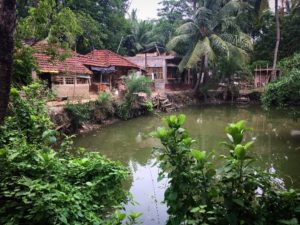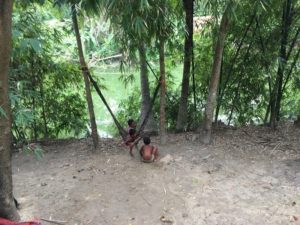Written by: Medhavi Gupta, PhD Candidate, Injury Program, The George Institute for Global Health
Dhan, nadi, khal ai teen e Barisal – Paddy, river and canal are three components that make Barisal – a Division in the south of Bangladesh. In this rural region, the majority of homes are close to open water and fisherman families are unable to supervise their young children. As a consequence, these children are drowning at an alarming rate. Due to the environmental make-up of the region, these communities are facing a child drowning epidemic.

Child supervision is an evidence-informed intervention to reduce drowning in pre-school children. 400 Anchal (translating to “mothers lap”) centres were implemented from 2017- 2019, supervising 10,000 children aged 1-5 years, 6 days a week from 9 am to 1 pm. The program was delivered by hired locally trained women who provided early childhood development activities to the children. They were supported by strong community engagement platforms such as Village Injury Prevention Committees (VIPCs) made up of local community members.
We wanted to understand four aspects of the Anchal program:
- Was implementation occurring as designed?
- How appropriate were the processes to ensure quality delivery of services?
- Were participants being reached as intended?
- What were the challenges and what innovative strategies were used to manage these?
In order to answer these questions, we analysed quantitative program data such as child enrolment and staff attrition rates and conducted interviews, focus groups, and observations with program staff and beneficiaries.
We found that the program was very successful:
- The average enrolment per Anchal centre was 22 children
- The program used a range of methods to engage the community, including video shows and home visits. There was strong community buy-in and employment opportunities for women in the community
- Children attending experienced co-benefits of improved language and social skills
- To support the implementation of Anchal in local communities, some VIPCs took initiative and implemented adaptations to the program, such as hosting Anchal centres in local schools which had better facilities and electricity connection
However, there was room for improvement:
- While 3-5 year old children thrived and had better participation, children aged 1-2 years old were less likely to enrol and attend. Young children felt separation anxiety and found the activities less engaging. Culturally, parents were also reluctant to keep their children away from home at this young age. The low attendance of this age group may reduce the effectiveness of the program on drowning, as 1-2 year old children are most at risk. Alternative interventions, such as barriers at home, may be required to keep children safe from water.
- Other environmental factors such as hot weather in the summer and cold weather in the winter reduced attendance, especially in centres without proper mats to protect from the cold ground or without continual electricity to run the fan.
- In some communities, VIPC members were not aware of their role and waited for Supervisors’ instructions. In turn, Supervisors had limited time to work with VIPCs. VIPCs were given no training or onboarding when formed.
- The program delivery team highlighted the need for “soft skills” development such as community engagement, mass communication skills, decision making and leadership.
- Context played a major role in Anchal’s success. One sub-region, Taltali, showed significantly higher staff attrition rates and lower child enrolment and attendance than others. Large geographic distances reduced parents’ ability to travel to pick and drop their children every day. Lower educational attainment at population level meant challenges in recruitment of local staff, training and thus impediment in program delivery. This sub-region required greater support and resources to ensure equal performance.
Overall, this study demonstrated the challenges of implementing community-based programs in rural low-resource contexts. The effectiveness and sustainability of the Anchal program can be improved through:
- Empowering community engagement platforms such as VIPCs for implementation, adaptations and conduct
- Acknowledging, and prioritising community needs such as providing meals to incentivise attendance and providing pick up and drop off services
- Continued support and growth of structures for program delivery
- Development of better suited interventions to protect children aged under 2 years old from drowning
Process evaluations are a powerful tool to identify strengths and improvements for community-based health programs employing and engaging local people, particularly in low-resource settings where context affects implementation outcomes. Such evaluations increase program effectiveness, sustainability and scalability through the identification of tailored and feasible solutions.

The full study can be read HERE.